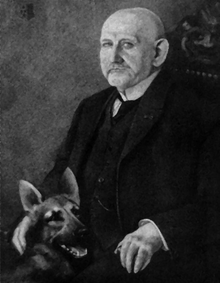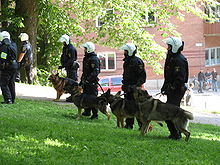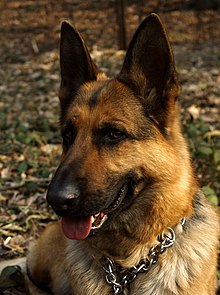German shepherd
The German Shepherd (German: Deutscher Schäferhund) is a breed of shepherd dog native to Germany. to 1899. They are part of the herding group, as they were dogs originally developed to herd and guard livestock. Since then, however, thanks to their strength, intelligence, trainability and obedience, German Shepherds around the world are often the preferred breed for many other types of work, such as: police dog, military dog, guard dog, guide for the blind, rescue animal, and others, according to the use given to it by the security forces and the army. In many countries they even have specific units called K-9.
History
Its origins date back to the end of the XIX century, when a breeding program for guarding and protection began in Germany of the flocks of rams against the wolves. German Army cavalry captain Maximilian von Stephanitz is considered the father of the breed. Later, after the appearance of the Association of Friends of the German Shepherd in 1899, a selection of specimens was started whose crosses improved both the mental and physical appearance of the animal.
The first specimen registered Horand von Grafrath was a vigorous animal, with a strong character, greyish fur and wolfish appearance that proved to be a stallion with the traits that Von Stephanitz was looking for. Those desirable traits were passed on to successor dogs at first meeting, and reinforced by the careful rules of selective breeding between members of the same lineage of this first breeder; a practice that sought to highlight and enhance desirable characteristics through a certain genetic management.
Von Stephanitz primarily sought the practical and working aspect of the breed. From the beginning, the shape of the German Shepherd should not divert you from its zootechnical functionality. Von Stephanitz foresaw a first threat to the breed's validity as a working animal when human society transformed from a primarily agricultural and ranching base to an industrialized economy. In a first phase, he persuaded the German government to accept the breed in police work. This was the beginning of the breed's association with law enforcement and military use. Soon the animal's qualities of intelligence, reliability and endurance, major aspects of its character and its existence in history, ensured its use in many important roles, one of those noblest roles being as a guide dog for the blind.
This breed was used as a sniffer dog during World War II by the German army and police. In fact, his services during both world wars earned him worldwide respect and admiration.
Features
General appearance: robust and flexible, slightly elongated, muscular body, jaws closing in scissors. It is a companion dog since it is a balanced, docile and easy to train dog.
- Variants of color in the German shepherds: solid black (total black), black with yellow, red, brown or light grey spots, black shoes (black with the lower part of the legs of yellow, red, brown or light grey), sable (grey colour combined with yellow, red or brown). White stains are not desirable, although they can be admitted. The truffle must always be black. All must possess a black mask, those who lack it are considered as missing specimens of pigmentation.
- Weight: the male rounds from 36 to 40 kg, and the female between 27 and 35 kg.
- ALTURA: the male is 60 to 66 cm and the female is 55 to 60 cm (the specimens are allowed up to 2 cm higher or lower).
- Life expectancy: 11 to 15 years
General information
Shepherd of cows and sheep with indefatigable trot and great intelligence. He has excelled in numerous jobs useful to man, such as: guard, guide dog, police, attack dog, drug detector, etc. It is a vigorous, agile, well muscled and alert animal. His physical proportions must be related not only to his appearance but also to his temperament. He is usually a well-balanced dog, with a harmonious development of the forelimbs and hindquarters. A good specimen pleases at first sight; it is also very strong. It can be aggressive at times and a bit domineering depending on the way it is raised. For all this he is a dog dedicated to work.
Head
It is wedge-shaped and in proportion to the length of the body (its length is approximately 40% of the height of the withers), without appearing either coarse or elongated. In its general appearance it is usually dry and moderately wide in the middle of the ears. Seen from the front and from the sides, the forehead is slightly arched and without or with a slightly marked median furrow. The proportion between the cranial and facial regions should be 50% to 50%. The width of the cranial region is almost equal to its length. Seen from above, the cranial region tapers evenly from the ears towards the nose, leaving a not very noticeable fronto-nasal depression and sloping into the wedge-shaped muzzle. The upper and lower jaws are strongly developed. The nasal cane is straight; any bulging or sagging is undesirable. The lips, dark in color, are firm and well attached.
Eyes
Medium in size, almond-shaped, set obliquely and never protruding. Their color is usually as dark as possible. Piercing light eyes are undesirable as they affect the dog's expression; that is why there are not usually dogs with this type of eyes.
The main problem is that they get dirty (especially if the dog lives in the city, because of the pollution). Normally, this dirt is removed in the form of rheum, which can be cleaned with a damp cloth. They should not be allowed to accumulate until the dog is bothered so much that he rubs himself with his paw.
In older dogs, or due to illness or injury, it may be difficult to maintain moisture in the eye. In this case, it is advisable to clean it regularly, after consulting the veterinarian so that he can indicate the appropriate product to use.
Ears
The German Shepherd Dog's ears are medium-sized, erect, spread forward, and carried evenly (neither turned up nor carried to the sides). They are pointed with canopy facing the front.
If earwax builds up, remove it carefully, just as you would on a person. But you have to do it with much more care, since due to the shape of the dog's ears, if the wax flakes are simply released, they will fall inside, potentially damaging the ear canal. If you're not sure how to do it, it's best to leave it to a professional; anyway, a good way to clean a dog's ears (both raised ears and floppy ears) is with a bit of cotton moistened with liquid Vaseline, always from the inside out of the ear, only what you can see, never reach further in as it can damage.
Ears will begin to plant at around five to six months of age.
Special attention must be paid to dogs of breeds that have floppy ears, which, in addition to accumulating "normal" dirt, can become nests for parasites, among other things, due to lack of ventilation, a disadvantage that the dog does not have. German shepherd due to the shape of his ears.
Body
The topline runs without interruption from the set of the neck on the well-defined withers and on the back it is straight to the croup. The back is firm, strong and well muscled. The loin is broad, strongly developed and well muscled. The croup should be straight, strong and continue towards the tail line without interrupting the top line.
Tail
It reaches at least to the hock, but not beyond the middle of the metatarsus. He has longer hair on his underside. At rest is carried hanging in a slight curve. When the dog is moving or paying attention, it carries its tail higher, but without exceeding the horizontal line. Corrective operations are not prohibited. It is also a defect that the dog has its tail standing up.
Forelimbs
Viewed from all sides, the forelegs are straight; seen from the front, they are absolutely parallel. The shoulder blade and the upper arm are of the same length, firmly attached to the body by means of good musculature. The ideal angulation between the shoulder blade and the arm is 90°, but it is generally 110°. Elbows are usually turned neither in nor out, whether the dog is at rest or in motion. The forearms, seen from either side, are straight and parallel to each other, dry and well muscled. The pastern has a length of approximately 1/3 of the forearm and forms an angulation with it of approximately 20-22°. A pastern that is too inclined (more than 22°) or too straight (less than 20°) impairs the dog's ability to work, especially its resistance. The front feet are rounded, compact, with arched toes. The pads are usually firm, but not brittle. The nails are strong and of a strong dark color, although there may be exceptions.
Hind limbs
Rump: The German Shepherd of the show line tends to have a drooping croup, this characteristic is most sought after for show shows and structure shows. A series of motor problems are attributed to this bone configuration, and consequently health problems, due to the malformations that this entails.
The specimens of the so-called working line, developed in Eastern European countries, do not have this characteristic or at least it is not so marked.
Health
German Shepherds have a life expectancy of between ten and twelve years. The German shepherd is one of the breeds with the most genetic problems due to its irresponsible breeding. As is common in large dogs, this breed often suffers from hip dysplasia. Responsible breeding is necessary to prevent this type of defect from spreading from generation to generation in order to have healthy specimens that do not suffer pain and are useful for work, so it is recommended to purchase the puppy from a certified kennel and demand to see the pedigree of the puppy and ask if his family has contracted this problem. This breed normally requires that the hips of the puppies be X-rayed and that the x-rays be certified and approved by the clubs responsible for the breed (the body that regulates this breed is the Verein für Deutsche Schäferhunde e.V. (SV) based in Augsburg, Germany); also when the dog reaches maturity (approximately two years of age) to guarantee it as an adult suitable for reproduction.
Another health problem that sometimes occurs in this breed is Von Willebrand's Disease. They are also prone to pancreatic deficiency, which means that the pancreas stops producing enzymes and the animal is unable to process or absorb anything. There is medication to treat it, although unfortunately it does not solve or cure the problem 100%, and also the treatment is quite expensive.
Other diseases that can occur are:
- Panosteitis: formation, growth and excessive inflammation of the bone around the joints causing in the known as the "cojera del puppy" (definition given by the AKC encyclopedia).
- Echin rubber syndrome: neurological signs resulting from the compression of the spinal nerves in the lumbosacra region.
- Canine corneal pannus (small chronic keratitis): inflammation of the cornea that can produce potential blindness, including abnormal tissue growth around the cornea.
General Training
The Schutzhund is a sport also known internationally as IPO due to the acronym of the German words Internationale Prüfungs Ordnung. Its purpose is to evaluate the character and usefulness of a dog for work, as well as the relationship with its driver. In its beginnings, its objective was to preserve the characteristics and capacities of the German Shepherd (through the selection for reproduction of only those specimens that had successfully completed, and finished, the tests), but currently any breed that requires a working test participates in it. according to the FCI. In recent years, the breed that tends to have the most presence in competitions is a variety of the Belgian Shepherd (Malinois).
But beyond the above, it has evolved into an exciting sport with hundreds of people and specimens, in dozens of countries around the world, practicing it every week, despite adverse weather conditions. In addition to developing regional, national and world competitions that bring together the highlights of this discipline.
White German Shepherd
Recognized by the F. C. I. currently as White German Shepherd, Switzerland.
For many years, detractors of the white sheepdog have suggested that its color derives from albinism. Their color comes from a single recessive gene, of which both parents must be carriers to continue the color. The eyes, nose, lips and paw pads are completely black, and it is perfectly adapted to work in the sun. The breed has a distinct personality: White Sheepdogs are more subtle, approachable, calm, and less aggressive than the normal Sheepdog. It is even-tempered, but when the occasion calls for it, it is alert and impatient, useful to serve in its companion capacity. guardian or guide
The recessive gene for white coat hair was fixed in the DNA of the German Shepherd Dog breed at the turn of the century XIX and the turn-of-the-century German breeding program XX, which used extensively "coated color', the dogs that carried a recessive gene for 'white coats'. Horand von Grafrath's maternal grandfather, the first entry "SZ 1" in the SV prisoner dog book, he was a white-coated German sheepdog named Pena von Sparwasser.
White was reported as a conformation defect to rule out at the SV (German Shepherd Club of Germany) in 1933 and by the German Shepherd Dog Club of America (GSDCA) and the German Shepherd Dog Club German of Canada (GSDCC) in the mid-1960s.
Celebrity specimens
- Horand von Grafrath, the first copy inscribed in the source book.
- Rin Tin Tin, television series based on the old American West.
- Blondi, the bitch who got Adolf Hitler.
Contenido relacionado
Megaptera novaeangliae
Bream
Notoryctemorphia











